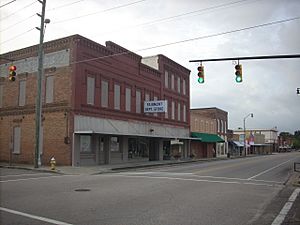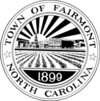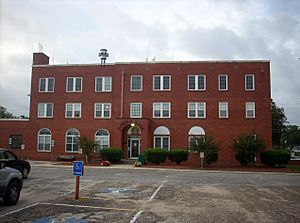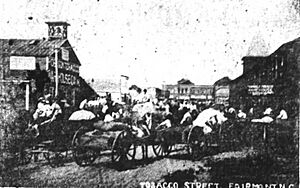Fairmont, North Carolina facts for kids
Quick facts for kids
Fairmont, North Carolina
|
|||
|---|---|---|---|

Main Street
|
|||
|
|||
| Motto(s):
"A Proud Past, A Promising Future"
|
|||
| Country | United States | ||
| State | North Carolina | ||
| County | Robeson | ||
| Area | |||
| • Total | 2.77 sq mi (7.16 km2) | ||
| • Land | 2.76 sq mi (7.15 km2) | ||
| • Water | 0.01 sq mi (0.01 km2) | ||
| Elevation | 118 ft (36 m) | ||
| Population
(2020)
|
|||
| • Total | 2,191 | ||
| • Density | 793.55/sq mi (306.44/km2) | ||
| Time zone | UTC-5 (Eastern (EST)) | ||
| • Summer (DST) | UTC-4 (EDT) | ||
| ZIP code |
28340
|
||
| Area codes | 910, 472 | ||
| FIPS code | 37-22360 | ||
| GNIS feature ID | 2406479 | ||
| Website | www.fairmontnc.com | ||
Fairmont is a town located in Robeson County, North Carolina, United States. In 2020, about 2,191 people lived there. It is known for its interesting history and its connection to farming.
Contents
Fairmont's History and Growth
Fairmont has had a few different names over the years! It was first known as Ashpole, named after the nearby Ashpole Swamp. In 1899, it was officially named Union City. However, the name changed back to Ashpole in 1901. Six years later, in 1907, the town was finally named Fairmont.
Early Settlers and Industries
The first people who settled in this area received land from the "Lords Proprietors." These were important people who owned large areas of land in the early days of North Carolina. The settlers worked in the logging business, cutting down trees for lumber. They also made "naval stores," which are products like turpentine and pitch. These were very important for building and maintaining ships back then.
A large lumber company called Bufort County Lumber Company opened in the late 1890s. It hired about 300 men and became one of the biggest lumber companies in the southern United States.
Tobacco Farming and Railroads
By the late 1800s, growing and selling tobacco became very popular in Fairmont. Railroads were built to quickly move these goods to other places. By the early 1900s, tobacco became the main crop. By the mid-1950s, Fairmont was considered one of the biggest tobacco markets in the world for its size. It was even called the "biggest little tobacco market in the world."
As people became more aware of health concerns related to tobacco, many local farmers started growing other crops. Today, they mainly grow corn, soybeans, and wheat.
Border Belt Farmers Museum
To remember its farming history, the Border Belt Farmers Museum was created in 1989. It is located in an old railroad building. The museum is full of items related to farming, tobacco, and the town's history. It is open five days a week for visitors.
Fairmont Today
Fairmont has recently started promoting itself as "the shortest route to the S.C. beaches." This means they encourage drivers traveling south on Interstate 95 to take exit 10 to visit the town. This advertising has brought more visitors and businesses to the community.
The Fairmont Commercial Historic District was added to the National Register of Historic Places in 2010. This means that area is important for its history and architecture.
Fairmont's Location
Fairmont is located in the Carolina Border Belt. This is an area with many tobacco markets and warehouses along the border between North Carolina and South Carolina.
According to the United States Census Bureau, the town covers an area of about 2.2 square miles (5.7 square kilometers). All of this area is land.
Fairmont's Population
| Historical population | |||
|---|---|---|---|
| Census | Pop. | %± | |
| 1900 | 432 | — | |
| 1910 | 730 | 69.0% | |
| 1920 | 1,000 | 37.0% | |
| 1930 | 1,314 | 31.4% | |
| 1940 | 1,993 | 51.7% | |
| 1950 | 2,319 | 16.4% | |
| 1960 | 2,286 | −1.4% | |
| 1970 | 2,827 | 23.7% | |
| 1980 | 2,658 | −6.0% | |
| 1990 | 2,489 | −6.4% | |
| 2000 | 2,604 | 4.6% | |
| 2010 | 2,663 | 2.3% | |
| 2020 | 2,191 | −17.7% | |
| 2022 (est.) | 2,188 | −17.8% | |
| U.S. Decennial Census | |||
Population in 2020
In 2020, there were 2,191 people living in Fairmont. There were 1,046 households and 644 families.
The population of Fairmont included people from different backgrounds:
| Race | Number | Percentage |
|---|---|---|
| White (not Hispanic) | 532 | 24.28% |
| Black or African American (not Hispanic) | 1,266 | 57.78% |
| Native American | 272 | 12.41% |
| Asian | 7 | 0.32% |
| Other/Mixed | 84 | 3.83% |
| Hispanic or Latino | 30 | 1.37% |
Population in 2010
In 2010, there were 2,663 people living in Fairmont. The population was made up of about 56.0% Black, 26.0% White, and 13.3% Native American people. About 1.9% of the population was Hispanic or Latino.
Notable People from Fairmont
Fairmont has been home to several notable people, including:
- Rod Griffin, a basketball player who was named ACC Player of the Year in 1977.
- Joy J. Johnson, a Baptist minister and state legislator.
- Effie Neal Jones, a civil rights activist.
- Joseph Mitchell, a well-known American writer.
- Thomas Avery Nye, Jr., a politician.
See also
 In Spanish: Fairmont para niños
In Spanish: Fairmont para niños






